 Inside Dore Abbey
Inside Dore Abbey Spring has been slow in coming this year and as we went into March the weather was getting steadily colder rather than warmer. Additionally March turned out to be as wet as February was dry. To begin with the reports, here is a slightly curious late entry from the end of February when grayling were our quarry. On the 28th SB from Solihull had 23 Lugg grayling at Lyepole using something he called “trotted blue-bottle emergers.” That’s sounds successful and certainly imaginative; I haven’t heard them called that before. My wife calls them “wrigglies” and by strict edict they are only allowed to be kept in a special fridge in the garage/tackle room where some bottles of beer also live. This was the first time at Lyepole for SB, but he is not the first to fall for the charm of this lovely valley
On the 2nd I celebrated what is the end of grayling fishing for most of us with a sunny morning at Abbeydore in the Golden Valley. Fishing at Abbeydore is always a lovely experience, for the surroundings if nothing else. There is a ritual to it, from a chat with the folks at Tanhouse Farm to the visit to the Abbey, the great Cistercian house which still dominates the valley. The Dore is deep-sunk and overgrown with alders so be prepared for a scramble. It’s also slightly unusual to be fishing for grayling on such a small stream, but some of the deep holes must suit them. As far as I know grayling live happily in the Dore as far upstream as a little weir at Vowchurch. On this day I used an 8 foot rod with a couple of nymphs and an indicator, and was pleased to find a couple of good ones amongst the catch. Normally Dore grayling are small, but like all Monnow system grayling they have that distinctive blueish shine to their scales.
The trout and salmon seasons opened on the 3rd and we had already been told that fresh fish were being seen in the Wye below Monmouth. These were mainly large, silver, three sea winter fish and in fact six salmon were taken on the first day. Bigsweir reported fish of 8 and 20 pounds, gillie Nathan Jubb had fish of 15 and 18 pounds from Upper Bigsweir and Coedithiel, Wyesham reported one of 15 pounds and up at Holme Lacey Colin Richardson had a fish of 16 pounds on a Flying C. Altogether not a bad start at all for the Wye, we thought. Wyesham had another of 17 pounds on the 4th.
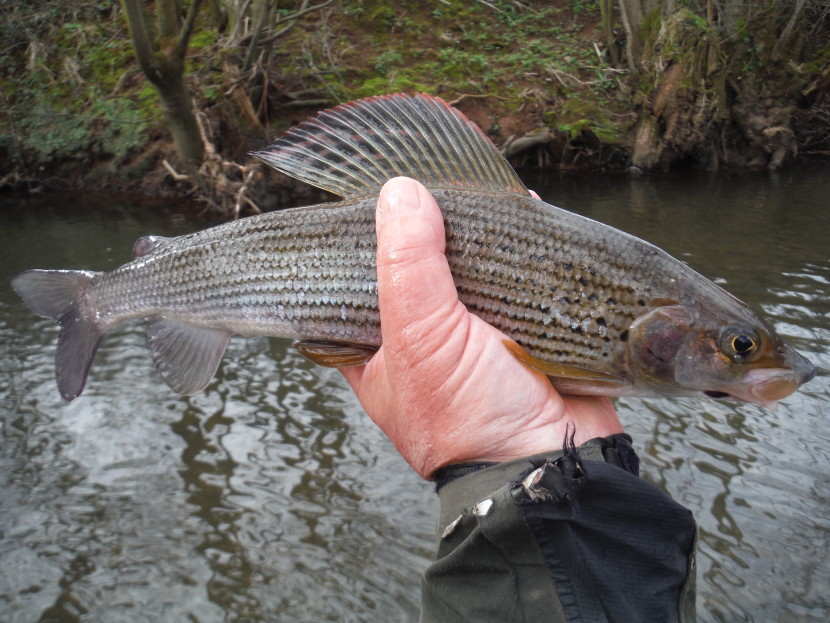 Abbeydore grayling
Abbeydore grayling 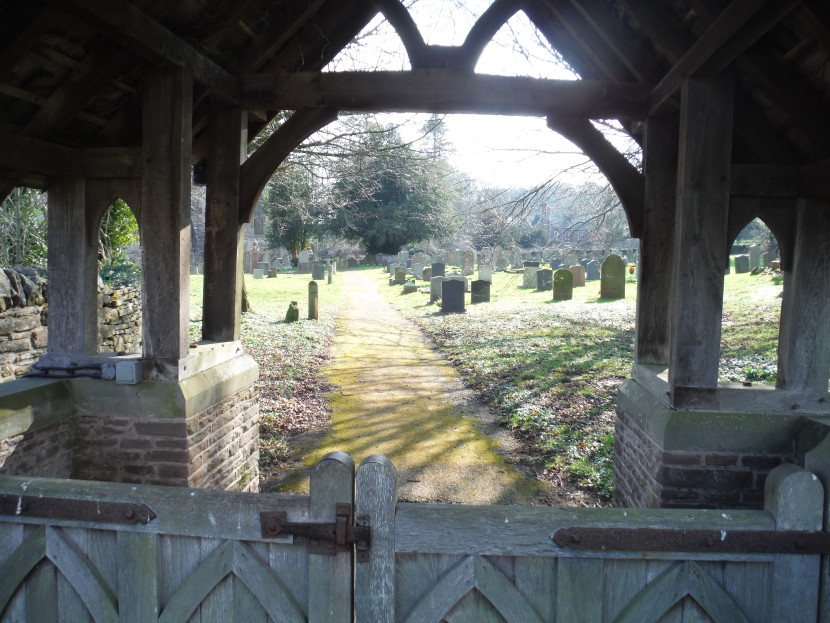 Dore Abbey lychgate
Dore Abbey lychgate 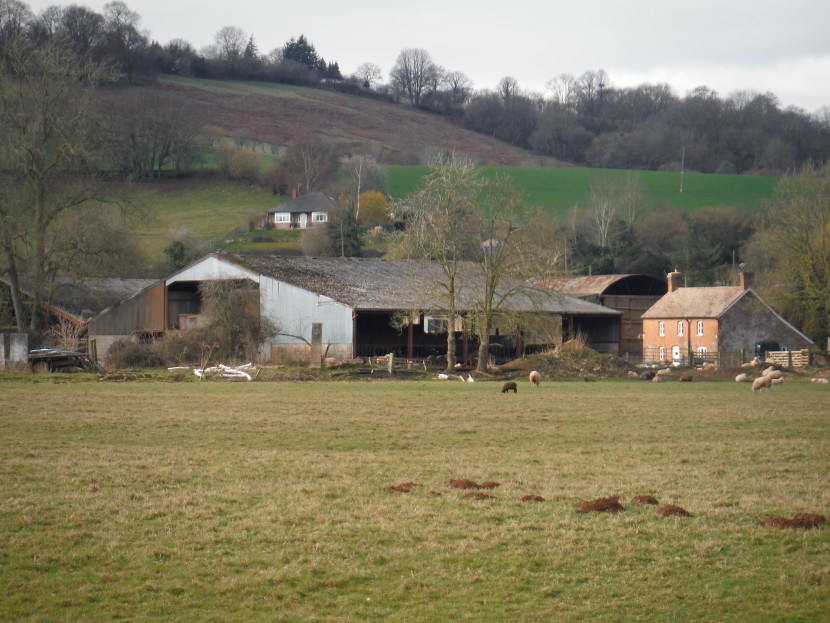 Tanhouse Farm, Abbeydore
Tanhouse Farm, Abbeydore Thanks to owner Barry Paraskevas I had my own opening day on the lower Usk at Chainbridge and found myself wading a very low, cold and clear river. The air temperature was 4 degrees, the wind blowing from the north-east and there was no sign of sun, or of salmon for that matter, although I searched the known spots as diligently as possible, scraping the bottom sometimes with a fast-sink tip and a small Black and Yellow tube. Cold as it was, large dark olives began to float downstream about 1.30 and there began to be a few rises from trout of different sizes. This cheered me up. On the off-chance I had put a trout rod in the car, although the hatch was almost done by the time I had made it up with a team of spiders. Nevertheless, there was time to cover a few late risers and two of them, both about 14 inches, took a Waterhen Bloa with a wonderfully positive draw, making a very nice start to the trout season.
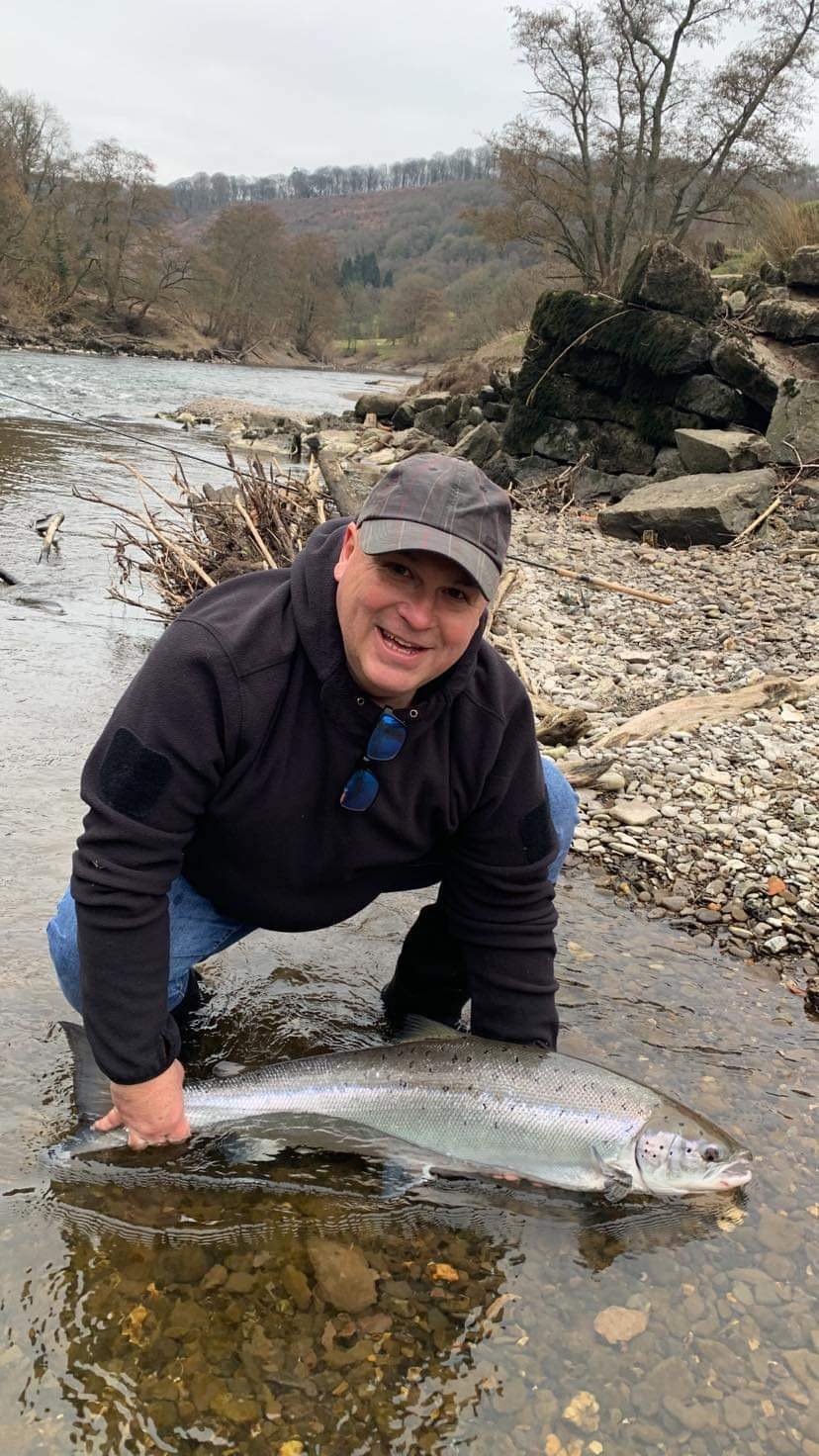 Lower Wye springer - Nathan Jubb
Lower Wye springer - Nathan Jubb I had a similar session a couple of days later on the MTAA’s beat at Kemeys Commander. A downstream wind under a mainly cloudy sky felt colder than ever, but on one of the long gravel runs I think I counted three distinct if short-lived olive hatches between 11 and 2 o’clock. Almost as briefly, a few trout were provoked to show on the surface as the little dark-coloured duns fluttered down. Using a team of spiders including the usual Waterhen Bloa I missed a couple but managed to net one thin post-spawning trout of 18 inches, plus a fatter, brighter-looking 13 inch fish.
TB from London was coarse fishing on Middle Hill Court on the 4th and raised the question as to whether this beat is double bank or not. If I understand the situation correctly, WUF inform that the beat is double bank, but there is no access to the right bank and thus anglers can expect there to be no “opposition” fishing on the other side. I doubt anybody would try to wade across that section. HL from Herefordshire was still pursuing grayling and caught 11 from the Lugg at Lyepole using nymphs. SL from Hockley Heath fished downstream at Eyton for 5 grayling and remarked on the very brief midday olive hatch. In my experience you can almost guarantee that hatch at this time of the year, no matter how cold it gets. JW from Cambridge had a couple of pike on dead baits from the Dean and Chapter with advice from local guide Ian Henderson. A from Treharris had 6 chub to 6.1 pounds at Canon Bridge using a straight-through lead to luncheon meat for bait.
Some hardy anglers fished on although the temperature was falling steadily day by day and winds were getting stronger. “In like a lion, but out like a lamb” is what they used to say about March. We could only hope for an improvement. BW from Stratford on Avon reported 8 grayling on nymphs from Lyepole. LH from Herefordshire had a very hard day on the upper Wye at Craig Llyn, but caught his first trout of the season on a dry fly. Needless to note again that the spring olives were hatching. GP from Oxford with two companions caught three pike to 14 pounds on ledgered dead baits at Courtfield. JC from Harpenden had 7 chub at the Home Fishery, one of which was attacked by a pike on its way in to the net. I imagine very cold and clear conditions such as these would tend to make the pike lively. Mark Brittain fishing at Wyesham had a 25 pounds spring salmon on a Green Highlander. That sounds like a wonderful fish on a classic fly pattern, although one not generally associated with the Wye. PV from Aylesbury, struggling to fish Cadora Backs in a cold gale, was surprised to be confronted by a grey seal in the river and wanted to know if a seal had been found so far upstream before. Unfortunately this is not so uncommon. Cadora Backs is affected by spring tides and there have been examples of seals taking up residence as far upstream as Monmouth. Was it “Valentino,” the name of the famous seal who spent some weeks at Monmouth a few years back? Unfortunately we know very well what attracts them into the river. It’s all too common to catch a salmon bearing a seal bite mark, usually towards the tail, and I dread to think how many of our salmon fall to successful seal attacks. There is an article in April’s Fly Fishing and Fly Tying querying why grey seals still need protection, given the modern growth in population numbers.
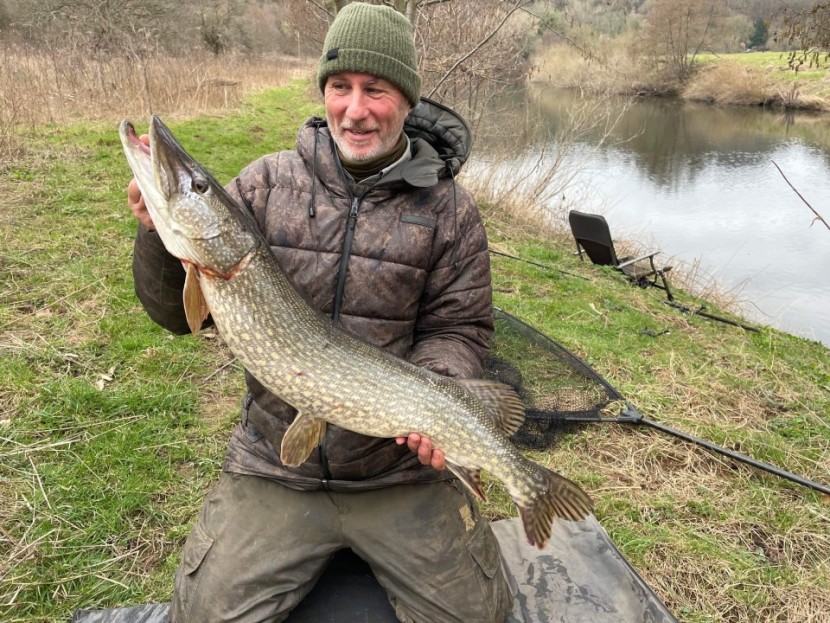 Courtfield pike - GP from Oxford
Courtfield pike - GP from Oxford 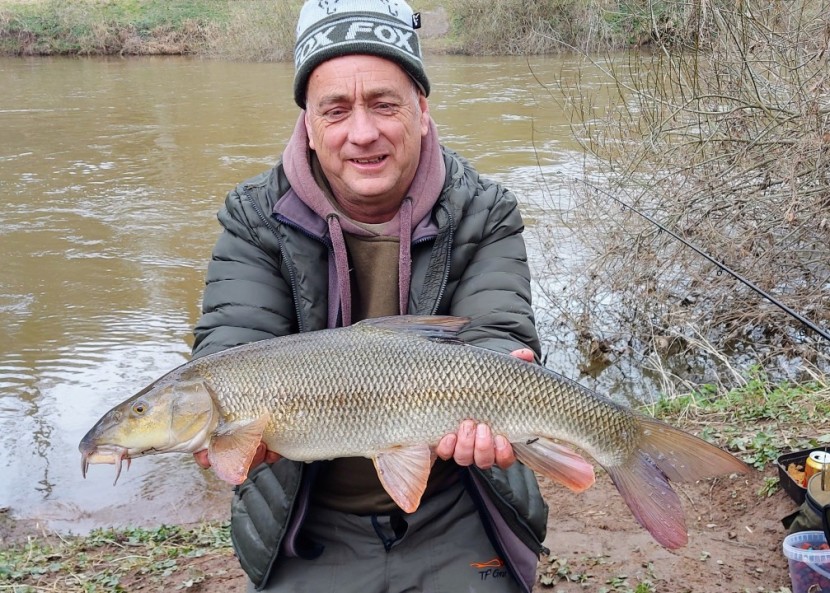 Middle Hill Court barbel 8 pounds - KT from Bath
Middle Hill Court barbel 8 pounds - KT from Bath  11th March at Strangford - MH from Wolverhampton
11th March at Strangford - MH from Wolverhampton Some very unpleasant weather caught us between the 7th and 10th March. The temperature was hovering around 1 or 2 degrees night and day, strong easterly and north-easterly winds made it feel much colder and heavy rain, sleet or snow according to altitude fell throughout the period. A 25 mph wind from the NE in March added to sleet and snow makes any river bank or pool a hostile environment. A few coarse fishermen stuck to their guns, chub and even some barbel were caught, but trout and salmon fishermen generally stayed at home throughout the period, presumably tying flies and perchance sipping whisky. That would have been my recommendation at least. Before long the rivers were affected as the precipitation overcame the drought of the previous month. The rise due to rain and snow melt water was not even at first however. The main Wye and the Usk were both slow to rise, but the Irfon came up to flood level and the Monnow also rose in a muddy torrent. Wyesham was proud to report a pair of springers weighing 16 and 19 pounds, both caught above the junction where the Monnow was pouring silt into the main river on the 10th. “Didn’t venture out to the river so built a snowman instead,” reported MH from Wolverhampton who was booked on Strangford and who sent us a picture of his work. Is it in fact a snowman or one of the other genders we keep hearing about? It looks a bit weird to me. By the 12th, when the temperature rose a dozen degrees, both rivers were affected by snow melting on the hills and the Wye in particular became very high and muddy. RM from Neath Port Talbot did manage a pair of thin post-spawning trout, 16 inches and 18 inches, taken on nymphs at the upper Usk’s Cefn Rhosan Fawr.
On Monday 13th a proper gale of wind and rain came through and all our rivers shot right up into muddy flood. Wind speed were gusting to 50mph. Clearly there would be no river fishing anywhere for a while. I had been hoping all week for a fishing session to myself on the Usk, but clearly the weather wasn’t going to co-operate. Other people take the dog for a walk on a wet and windy morning. We don’t have one, so that avenue of pleasure is closed but I must have some fresh air at some point in my routine. Off I went in the gale to our Forest Pool, trying to park where the car would not be damaged by falling branches. We have quite a lot of overwintered rainbows weighing 2.5 to 5 pounds in the lake at the moment and they fight hard. By March it can be exciting to fish three buzzers on a long leader with a floating line, but given the blustering wind on this day I was not quite brave enough for managing a team of flies. Instead I used a 10 foot 6 weight rod with a clear intermediate line, a 9ft leader of 3x fluorocarbon and a single fly. This would have been a lure, but the lake was fished by members quite a lot during the earlier mild weather, so that fish had taken to nervous tail-nipping when shown a large Humungous or Cat’s Whisker. I opted for a virtually tailless Black Blob, which is either going to be taken or it is not, and began to search my way through the muddy water, using a slow figure of weight retrieve. What with the wind and rain in my face combined with the obviously deteriorating colour of the lake, I wasn’t that optimistic. However, right at the head of the pool into which the strong wind was blowing I came onto a shoal of rainbows which were packed in tight. I began to get wrenching takes and caught three of them to 4.5 pounds before the shoal became nervous and moved away. The remarkable thing was that every one of these fish immediately on being hooked ran me right across the lake unspooling fly line into the backing. A couple more jumped themselves off with the whole line out. You would think that by the end of the winter fish would be thin and weak, but in my experience triploid rainbows caught in March give a very good account of themselves. I didn’t stay long, but you never can tell when fishing is going to be interesting or even spectacular.
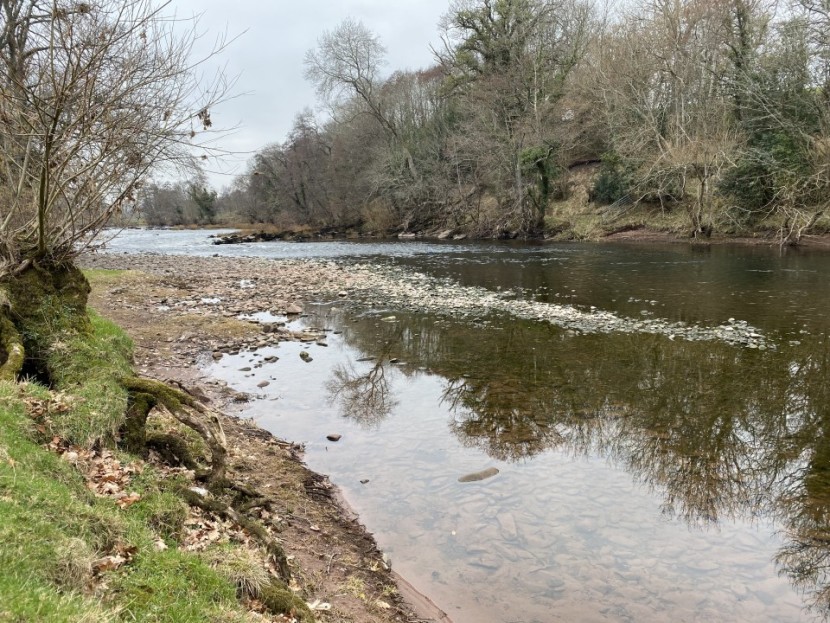 Abercynrig spring - FR from Hereford
Abercynrig spring - FR from Hereford 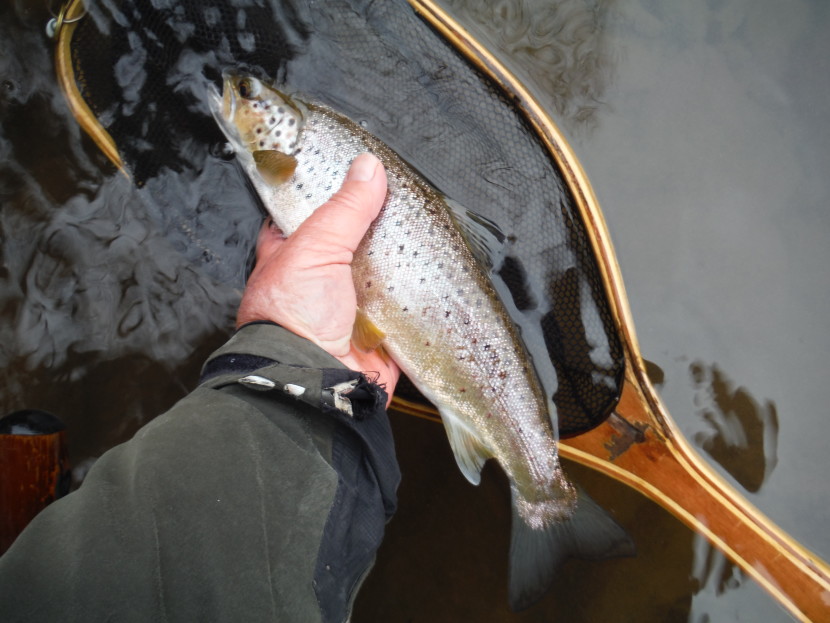 First of the season
First of the season  David Burren on the Breconshire Fishery
David Burren on the Breconshire Fishery 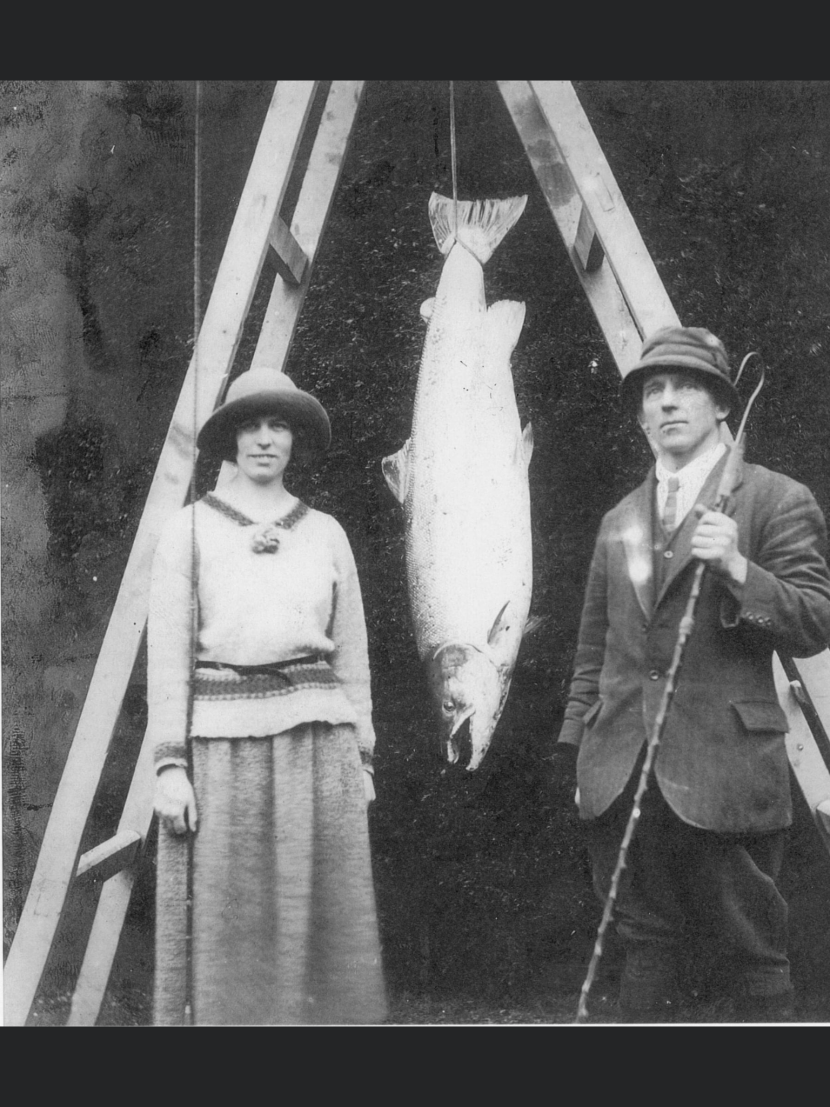 Doreen Davey and the big one
Doreen Davey and the big one When I got home I found a reminder from Dean Epton via the WUF that this very day was the hundredth anniversary of the record Wye salmon taken by Doreen Davey from her father’s beat at Winforton on 13th March 1923. The salmon weighed 59.5 pounds and was taken with a Hattons of Hereford artificial minnow in the Cowpond Pool. Miss Davey was then 18 years old and the oft-told details of the capture and her epic battle with the giant fish merge at times into the mists of legend. The struggle apparently went on for hours and the gillie supposedly had to light a fire of old newspaper sheets on the bank to see by while he was gaffing it. The monster salmon, in beautiful condition as we can see from the photograph, was duly weighed, witnessed, and a report sent to the Fishing Gazette. On publication, so we are told, Miss Davey received several offers of marriage through the post. The fish didn’t quite compare with the one of 64 pounds taken from the Tay by Georgina Ballantyne on 7th October the previous year, but it has been counted as Britain’s record springer.
I was surprised and impressed on the 16th when RB from Worcester reported 6 trout from the Usk at Dinas. The water looked to have cleared a little by then, but the WUF gauge at Brecon was still showing something like 20 inches. Well done! By the weekend levels were high but the water was mostly clearing. Air temperatures were also more spring-like, and this probably tempted more anglers to try to fish, both for salmon and for trout, in what most would consider rather marginal high-water conditions. Many failed, but there were successes too. AL from London with a friend took 20 Usk trout from Dinas on the 18th, mainly with spiders during a large dark olive hatch. GM from Ammanford reported 5 trout from the Usk reservoir using black and green lures, while YA from Mountain Ash took 6 from the same water. On the 19th SR from Maesteg took 10 wild trout on the Talybont reservoir with small black lures. Lyn Davies sent in a photograph of a fine trout taken during a March brown hatch on the Loughor near the border of Carmarthenshire. Due to the area’s traditional obsession with sewin, one did not hear so much about fly hatches on the little Loughor, but now that sea trout have become rarer and the stay at home brown trout apparently bigger, local anglers are taking a new perspective. LE from Usk had 6 trout from the upper Usk at Penpont, while SB from Neath had 10 on spiders from the Breconshire Fishery.
Another band of rain across the country on the 20th and the upper rivers were back in high flood so that fishing was hardly possible although some tried. There was still sometimes a reluctance to recognize the extent of the problem: “Level was a little high but the water rushing through and it was thick with colour resembling gravy.” To me that description of Skenfrith water levels is not just “a little high,” that’s a flood by any measure! On the main Wye Laurence Birkin managed a three sea winter fish while spinning at Aramstone before the new slug of muddy water arrived. Dave Roberts caught a 12 pounds fish at Ingestone. One consoling thought was that Wye springers might now have a chance to run right to the upper beats and in fact on the 22nd fish were spotted passing through Glanwye just below Builth Wells.
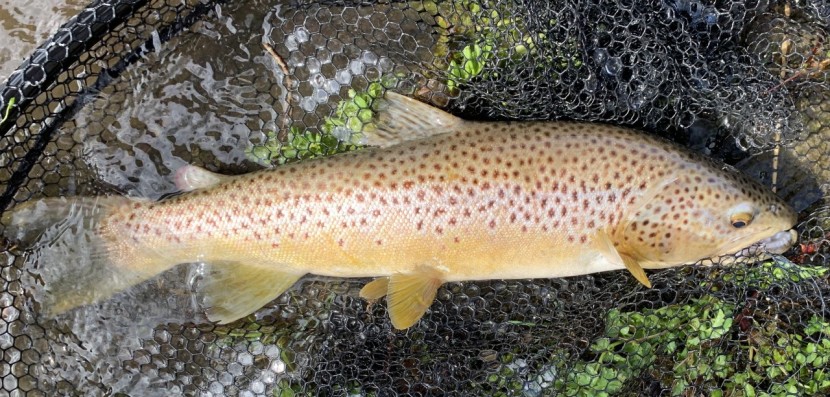 Gromaine trout - JC from Ilminster
Gromaine trout - JC from Ilminster 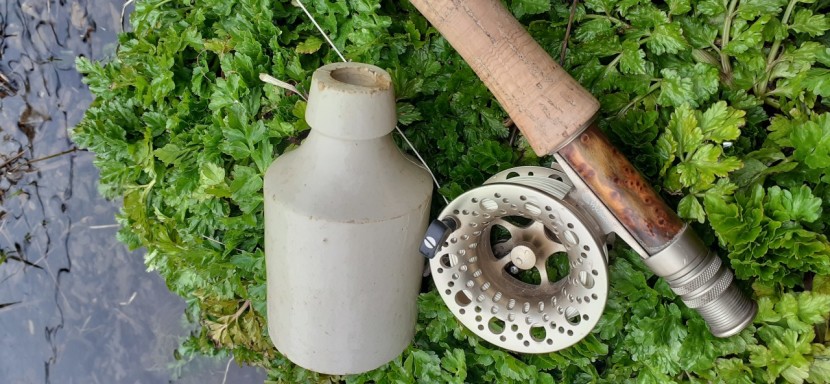 Hundred House pottery - JA from Rhayader
Hundred House pottery - JA from Rhayader While we waited for levels to drop the lakes were still available: SH from Chepstow caught 2 browns and 3 rainbows spinning at Llwyn On and JL from Hengoed with three friends had a dozen browns on the Usk Reservoir. I had a couple more good mornings on our Forest Pool, now in warmer weather with the margins full of mating toads. I was using a floating line with long leader, a Stick Fly on the point and a Diawl Bach on the dropper. One or other of these would be taken with tremendous force as they were fished round in a wind. The Stick Fly for me is the resurrection of an old sixties favourite following a recent article by Jeremy Lucas. Associated with the legendary nymph fisher Arthur Cove, in theory it represents a caddis grub peeping out of its case, but in practice, tied on heavy wire hooks and used on the point, it makes an excellent anchor for a team on a windy day. It seemed to work now better than ever. A client during a windy weather session at Big Well had his final rainbow of the morning fishing in what I always think is an exciting manner. He had cast a floating line across the gale which was pulling it round in a curve through the ripple until the single tiny black Pheasant Tail Nymph was suddenly taken just under the surface. The fish hooked itself and the line tightened so quickly it threw off spray. A sort of “hiss” which seemed to occur while this happened was probably my imagination.
 March brown feeder from the Loughor - Lyn Davies
March brown feeder from the Loughor - Lyn Davies 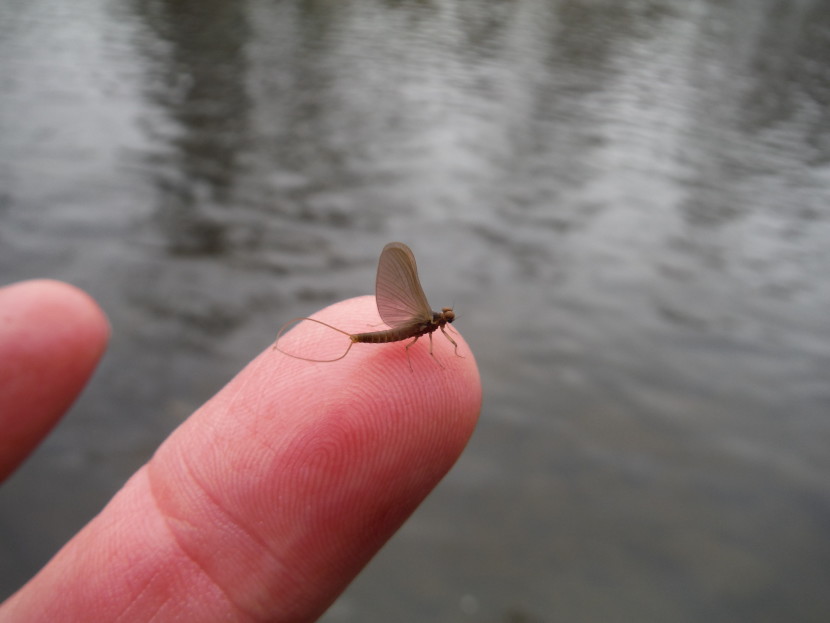 Large dark olive
Large dark olive 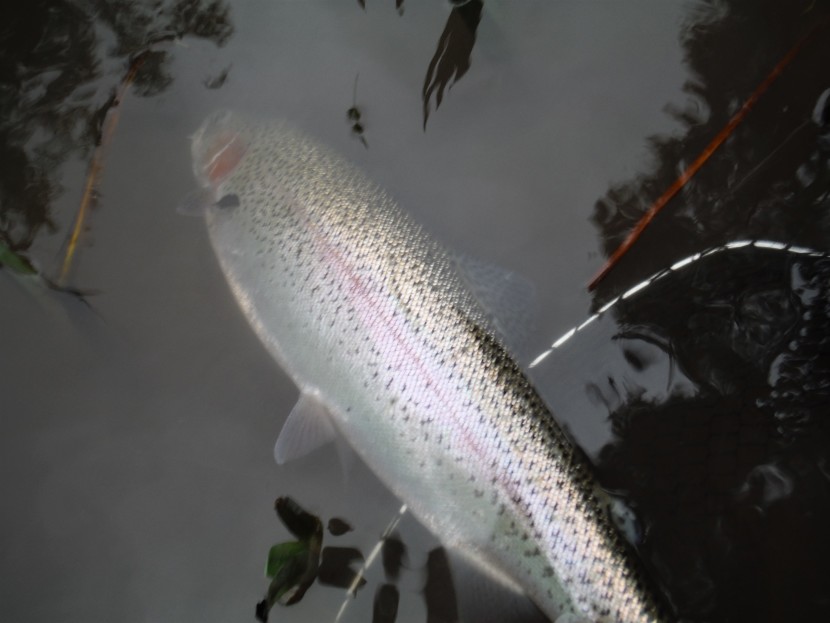 Overwintered rainbow
Overwintered rainbow The Usk by now was running clear but very high and difficult to fish due to continuing showers. Under such conditions a wise angler will pick a beat as far upstream as possible. On the 25th PD from London opted for Penpont, which is near the top of the river, but in places has some quite straight forward wading in gravel bottomed pools. In that sense it has the characteristics of the middle and lower Usk. Using nymphs, he got two heavy trout from the bottom end by the camping site. MH from Swansea fished the Breconshire water a couple of days later and got 5 trout on an Usk Naylor and a Pheasant Tail Nymph. Olives and a few March browns were hatching. AJ from Yeovil with a friend had 10 trout from Dinas on the 28th, but it rained all day on the 29th and, while remaining relatively clear, the Usk rose once beyond flood level – 1ft 11 inches on the Brecon gauge. On the 30th Ross Angling Association’s Richard Woodhouse, a mustard-keen salmon angler if ever there was one, caught a fish of 20.5 pounds, silver, but not sea-liced. He was spinning the Hom Pil pool above Goodrich with a Flying C and had found a little gap between two floods. Nevertheless the Ross gauge showed 1.27 metres, which is perhaps twice the ideal reading, so it was quite an achievement. On the last day of the month the grey skies were still pouring rain onto our waterlogged countryside and all the rivers were in flood. Admittedly it was now a little warmer and blossom was starting to show.
“Give them artillery and you have made them independent.” There is a famous line for you, and one containing a widely acknowledged truth, from Robert Bolt’s Lawrence of Arabia screenplay. A few weeks after the 1995 Dayton Agreement and the US-led NATO deployment which ended the Bosnian war, I was reminded of that statement by something I saw. At the time I was driving from Sarajevo down to see my in-laws in Mostar. I had reached the dramatic part of the trip in the long canyon north of Mostar, where the blue/green Neretva threads its way between cliffs thousands of feet high. The mountains here reach 6,000 feet and the gorge cut by the river is stark and spectacular. At this time much of the road was still a war-time military track, but an emergency repair had recently been made to a blown bridge. For this reason, the UN operation by which blue-helmeted Slovakian soldiers had used two motor launches to push a raft carrying our cars and trucks up and down the hydro-electric lake had now been withdrawn. A railway line follows the same river gorge, tunnelling its way in and out of the mountains above. It had been a famously scenic route in pre-war days and in summer months a holiday express train had even run from Stuttgart all the way through Sarajevo and Mostar down to Ploce on the Adriatic.
An eventful six months after the particular day and journey I am describing, by which time Bosnia and Herzegovina was enjoying its first uncertain summer of peace, this would be an altogether more pleasant drive. By then private cars were appearing back on the roads. The baker had opened up again at Ostrozac and those driving between Mostar and Sarajevo had resumed the pre-war habit of stopping to buy a half loaf of fresh bread spread with kaimak clotted cream. At Konjic the old man who made and sold carved wooden pipes had set out his stall again by the road. And on the mountain climb towards Sarajevo the kids who had gathered wild strawberries in glass jars waited on slow bends to sell them to passing drivers.
However during the dark war years the canyons and dams north from Mostar were known as a remote and dangerous area with a nasty reputation for hi-jackers and worse. Gangs of renegade Muslim soldiers such as those of Jusuf “Juka” Prasina, who at times had worked for two of the three sides in the Bosnian conflict, and the band of Zulfikar “Zuka” Alispago had roamed with impunity. The Croat populations of the little villages of Grabovica and Trusina inside the canyon were massacred during the second year of the war. Even by the standards of Balkan wars, the conflict between Muslims and Croats in Herzegovina during 1993 and 1994 was peculiarly vicious. I am glad to relate that Juka is definitely dead, having later been killed by his own bodyguard beside a motorway in Belgium. The Hague having transferred responsibility to the national Bosnian war crimes tribunal, seven soldiers of the BiH Army Zulfikar unit eventually stood trial in Sarajevo for crimes committed in the Neretva canyon and subsequently served modest prison sentences. Zuka himself owned a restaurant in Sarajevo after the war and for years avoided justice by claiming to be too unwell to face it. The last I heard, his lawyers were still successfully resisting trial on medical grounds.
On the day in question, with the ceasefire still new and shortly after NATO’s arrival, there was no traffic, nothing to be seen on the road except my white Landrover. There had been no rail traffic whatsoever in the canyon during wartime and I had always assumed the line was blocked somewhere and tunnels or bridges destroyed. Now I realised I had been wrong about that. In fact on this day the line was being used for the first time in four years. Two huge diesel locomotives in tandem came into view around a corner, plumes of black smoke rising as their engines laboured. I pulled over in surprise and watched as a long train of flat-bed trucks moved slowly up the canyon. Chained down to the trucks were freshly painted green tanks, seemingly identical and all headed north for Sarajevo.
A little consideration convinced me firstly that they must be American and secondly that the reason for their arrival was pretty obvious. What do you do when you want to stabilise and damp down a recently ended conflict? One likely answer would be to arm the weakest party to achieve a power balance. It would have been a carefully considered decision. Subsequent inquiries confirmed that these were indeed American M-60 Patton main battle tanks. A total of 45 Pattons, having been superseded for the US Army by the newer Abrams M70, had been taken out of their storage on a US base, put on a Saudi registered ship and offloaded at Ploce on the Adriatic coast of Croatia before rail transfer to Bosnia’s capital. Patton tanks represent post-WW2 1960s technology, but they would have been a match for the Soviet-made T55s used by local forces during the recent war. They are in Sarajevo to this day.
There is a psychological effect caused by tanks which in action are particularly frightening as any civilian unfortunate enough to have been shelled will tell you. When the distant thump of a howitzer signals its launch, there are a few seconds to get under cover or into a ditch before the lobbed projectile arrives and falls. A tank gun fires with a flat trajectory and what you hear without any other warning is a sudden double crack and the scream of the shell going overhead. Military opinion has changed several times about the value of armoured tanks over the century during which they have existed. Many officers regarded their invention and initial introduction during WW1 as nothing short of crazy, but still anything was worth trying to break the deadlock of trench warfare. At the end of the Great War, even the relatively primitive early models were starting to prove their worth. By the 1940s and the German use of blitzkrieg tactics, the military power of nations was no longer being judged by the number of capital ships they had at sea, but by the number of armoured divisions of main battle tanks they could deploy on land. WW2 ended in Europe with Russian and American tanks overwhelming the German Panzers, and quality and numbers of tanks, allied now to air power, were arguably what counted more than any other factor. The same reasoning continued into the 1950s when calculations being made about a potential battle to be fought between NATO and Warsaw Pact forces on the North German plain.
The Vietnam War changed a lot for the Americans, just as Afghanistan did for the Russians. Tanks lose a lot of their advantage when the terrain is no longer flat and the jungle is no place for them. Tanks also proved to be extremely vulnerable to air attack during the various Arab-Israeli wars and in Operation Desert Storm. Military thinking now turned instead to helicopters to move the infantry forward combined with closely co-ordinated air strikes and these were certainly the tactics which had been studied by the US cavalry forces I worked with after the Bosnian War. By the late 90s, when so many international missions involved, not war-fighting, but peace keeping or peace enforcement, situations in which mainly the threat of military force is used to back up soft power and diplomatic initiatives, there didn’t seem to be much need for anything as crudely powerful as a battle tank - or artillery for that matter. In Bosnia, the local balance of power having been settled to NATO’s satisfaction, the matter of what you do with 155 millimetre howitzers when supplied to a peace-keeping mission was a problem which exercised the Americans for a while. Tow them around occasionally to show everybody that you have them was the eventual conclusion. The big guns and their crews from the American south were sent home early.
I can think of one post-war exception involving a German-made Leopard tank, which eventually became known in Bosnia as the “Svjetlica incident.” In 1998 when I had the UNHCR office in Doboj, we experienced a really difficult 24 hours involving simultaneous road blocking demonstrations by displaced Bosnian Serbs and displaced Bosnian Muslims. This happened either side of a road tunnel right on the inter-entity boundary line. I was pretty sure at the time I was going to get the blame from everybody for this as the quarrel involved one of our most difficult hotspots: a partly destroyed Muslim village just a few hundred yards into what was now the Serb entity, the lower part of which had been occupied by displaced Serbs. The Muslims wanted to reoccupy the upper part of their village. For weeks we had been chairing meetings between the two groups without getting an agreement. Now finally the Muslims had lost patience and moved in; the Serbs had reacted and kicked them off at once. The fight had mainly involved sticks and stones but a hand grenade had been thrown and some-one was injured. The Muslims immediately staged a protest demonstration blocking the main road between Sarajevo and North Bosnia on their side of the tunnel. The Serbs responded with a mirroring demonstration blocking the road on their side. The front line of those sitting on the road were mostly women and the elderly, but you could see the younger men with walkie-talkies organising in the back ground. Local police on both sides stayed away. Fires were lit on the barricades when night drew in and the mood grew rather ugly. For a while my car was trapped between the two sides, while I went back and forth talking to the community leaders, to no effect at first. Eventually we extricated ourselves via the Serb side and my boss with his team came up from Tuzla on the Muslim side. It was a long cold night, which we knew from experience might eventually count in our favour. Rain would have been even better; it’s hard to maintain an open air sit-down demonstration through hours of being soaked.
Unfortunately UNHCR was under the gun when it came to time. NATO stabilisation forces let us know that they needed this main road north between Sarajevo and the vital military bridge across the Sava to Croatia. We had been given 24 hours to clear the road by negotiation or SFOR would do it themselves and now the time was almost up. Our local SFOR unit was the Nordic-Polish Brigade, a very efficient unit composed of both members and non-members of NATO at that time. Just before dawn I became aware that Danish Battalion was preparing something in a second tunnel round the corner from my position near the Serb road block. I walked back to see that my friends the Danes, who normally drove around in stripped down Mercedes jeeps with automatic rifles mounted on the bonnets, had brought out one of their Leopard 2 tanks and fitted it with a bulldozer blade on the front. The diesel engine was already rumbling away. “Half an hour,” they said. More than a bit concerned about how this might pan out, I walked back once more to my recalcitrant Serbs, but I need not have been worried. They had got wind of what was going on and were already dismantling their road block. As soon as the road was half cleared, the tank came blasting through the corner with the blade sweeping away the remains of the barricade and disappeared into the tunnel. Simultaneously Santiago told me on the radio that the Muslims were dismantling their block and dispersing. The Serbs were delighted to hear this. In fact the locals were giggling like naughty school boys caught out in a prank but the road was now open. Thankfully and after some more talking, that particular displacement and return problem was resolved, almost as if the moment of conflict had let out some bad blood before compromises could be made. However, even if the bluff was well judged, it was somewhat unnerving to be playing mind games backed up by a Leopard tank. I suspect that was the closest that Danish Battalion came to using one in Bosnia. Come to think of it, several years later I was involved with the Americans in another peace-keeping incident in east Bosnia, which ended with a confrontation between a tank and a rubbish truck. But that’s a story for another time.
Now in Ukraine we have a situation where everybody seems to believe that as the spring offensives begin the possession of main battle tanks may determine the outcome of the war one way or the other. Zelensky is clearly desperate to have them and states that he needs 300. The UK, bullish as ever on the subject of the Ukraine, early in January committed 14 out of our 100 odd Challengers. The Challenger is a good tank, but not ideal from the Ukrainian point of view, as it requires specialised training and uses some very specific spare parts and ammunition. It is widely believed that Britain made the offer in hope of provoking other likely donors, specifically the USA and Germany, to follow suit.
At a NATO meeting in Germany on 20th January, the USA seemed to sit on their hands. In fact their M70 Abrams also would not be ideal for Ukraine due to a massive jet fuel consumption for its turbine and some quite detailed technical operational requirements. The tank which Ukraine really wants and needs is the Leopard 2. Germany has made around 2,000 of these, for its own use and that of many customers around Europe. They exist, they are well-proven and could be delivered quickly. However, according to the contracts they can only be donated or sold on to a third country if Germany approves. It took some time, but eventually the Americans agreed to a company of Abrams and the Germans then reluctantly agreed to release a similar number of their Leopard 2s. What was really important was that the Germans stated that they would not object to other nations with German built Leopards contributing them to Ukraine, which laid the way open for Poland, for example.
 Leopard 2 for delivery - Michal Krynski
Leopard 2 for delivery - Michal Krynski 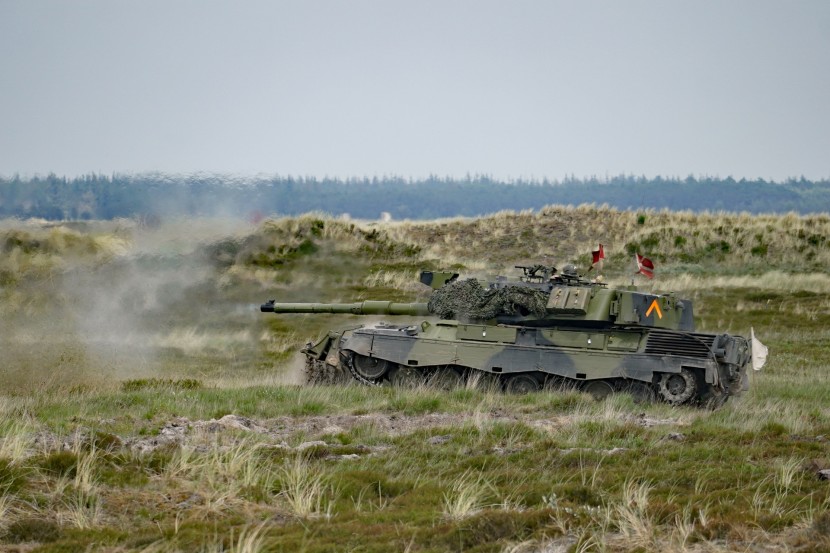 Danish Leopard 2 firing- Karsten Madsen
Danish Leopard 2 firing- Karsten Madsen At the time of writing some 140 Leopards have been promised along with another 14 British Challengers plus the original British and US donations. Thus Zelensky might eventually receive nearly 200 out of the 300 tanks he asked for. Whether any significant number can be delivered and made ready in time to resist a spring offensive by the Russians, or indeed for a Ukrainian offensive, is an open question. Putin made one of his cold-blooded comments: that NATO tanks would burn on the battlefield like any other. Zelensky is now pleading for fast jets from the Alliance. At the same time the Ukrainians are firing off ammunition faster than NATO nations can manufacture it, so that production and military budgets must necessarily rise. Meanwhile and in a grim forewarning of revelations likely to come, the Office of the UN Commissioner for Human Rights accused both Ukraine and Russia of war crimes which they have documented in detail including the torture and summary execution of recently captured prisoners. This news was broken by Matilda Bogner who leads the UN’s field team on human rights abuses in the Ukrainian theatre for Commissioner Volker Turk.
Well done to the 21 Conservative MPs who voted against the so-called Stormont Brake. DUP members could be relied on anyway to stand firm. Legal analysis of the much vaunted Windsor framework makes it clear that it offers no real protection from interference by the EU in the affairs of Northern Ireland. I do wonder, will we ever complete Brexit by bringing Northern Ireland out with the rest of the Union? It is 7 years now since the British public voted on this issue and still we wait.
Now here is a suggestion for an arrangement if the EU is so determined to avoid a land border on the island of Ireland. The EU can create a sea border between the Republic of Ireland and France. The Republic of Ireland will become part of the United Kingdom market and subject to our laws. However, there will be a “green lane” for goods travelling from the EU to southern Ireland and not going on to the north. Only 23 pieces of documentation will be required for green lane traffic. The UK will deploy officials to Irish sea and air ports to ensure compliance and the UK Supreme Court will have overall jurisdiction in the case of disagreements. However, in the case of new UK legislation being unwelcome in the Republic of Ireland, there will be something called the “Dublin Brake” by which after consultation such UK legislation affecting Ireland might, in some circumstances, be challenged.
How do you like that idea Dublin and Brussels? No? I thought not. That’s just how we feel. In which case the only acceptable solution is surely to have a land border exactly where it is now and has been for the last century. The UK has no intention to erect any extra infrastructure on the Irish border, which is already covered by numerous cameras for reasons which must be obvious. The EU and Republic have every right to erect infrastructure on their side of the border if they wish to, but I would suggest they have no need to. Oh how much easier it would have been if we left the EU without a deal! There would have been a bumpy few months while the EU decided whether they did or didn’t want to keep trading into the world’s fifth biggest economy, after which we could all have moved on.
The 21 rebelling Tories included Boris Johnson who took a 15 minute break from his Star Chamber grilling on Partygate. It has always seemed surprising and indeed a bit rich to me how sensitive the House of Commons is to the idea of being misled, or – let’s be blunt – lied to. The House after all is an institution full of politicians who seem to make a profession of misleading the rest of us all the time. I watched the privilege committee’s proceedings with a growing sense of depression while also feeling pretty annoyed about the various lawyer’s dodges, traps and barely concealed malice displayed during the interrogation. Anything which might work to bring him down. Johnson kept his temper most of the time, but bit back sharply one or twice. I believed his assurances, but the committee seemed to be trying to invent a new offence which is not misleading the House deliberately, but instead recklessly. Finally, they had the cheek to demand from Johnson an acknowledgement that the composition and actions of the committee had been fair, which clearly they had not. We, or those of us still interested, await their pronouncement. It was a sorry affair altogether.
There should be some good fishing in April but we really do need it to stop raining for a bit.
Tight lines!
Oliver Burch